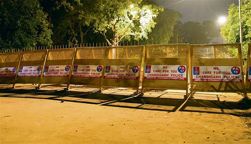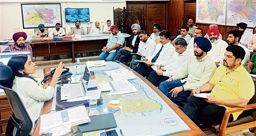
DR ANNPURNA NAUTIYAL
Frequent calamities in the Garhwal Himalayas in recent years are becoming a major concern for people, environmentalists and policymakers. These calamities occurring either due to natural or anthropogenic factors have made a deep impact on the socio-economic condition of the population living in these hills, particularly women who are the worst sufferers and most vulnerable to these effects. Since people in the hills are dependent on forests and the surrounding ecosystem for their daily subsistence, the climate change vulnerabilities and disasters are not only adversely affecting their sources of livelihood but also their lifestyles. As vulnerability is the inability of an individual or a community to resist the effects of a hostile environment, people’s immediate environment determines the degree of risk to their life and livelihood. A decline in the availability of firewood, fodder and water resources, increase in incidents of forest fire, soil erosion and changes in the land use pattern are being witnessed due to growing ecological imbalance, which are affecting human well-being and enhancing their vulnerability. The extreme weather conditions are affecting the poor, women, and marginal sections of the hill society more because of their dependence on agriculture and forests for their livelihood. Besides, lack of social networks, social support mechanism and essential services and poor infrastructure are also limiting their ability to cope with disaster-related challenges.
Dependence on natural resources
The dependence of women in the hill areas on natural resources for water and wood to perform their traditional roles of nurturers and caregivers make them more vulnerable. Therefore, any scarcity of natural resources affects them more as it not only increases time and labour in arranging these but also adversely affects their health and energy. In view of this, women generally possess a caring attitude towards these resources. The Chipko movement by uneducated women in remote Raini village of the Garhwal Himalayas in the 1970s against the unjustified commercial felling and cutting of trees is an example of such concern. Recently, a women’s movement at Maletha village in Tehri Garhwal district against the opening of polluting stone crushers in their fertile agriculture area is another example of women’s sense of belongingness and concern for their environment. Support from men and a few NGOs to this movement ultimately forced the district administration to cancel the permits of the stone crushers.
In the aftermath of the June 2013 disaster, hill villagers started migrating in large numbers due to safety concerns, destruction of infrastructure, scarcity of resources, lack of good quality schools, education and health facilities, diminishing sources of livelihood and loss of agriculture land. The en masse migration of villagers to nearby urban areas or plains rendered villages largely deserted and also disturbed the link of migrants with local cultural and religious practices and dialect.
Low agriculture yield a disadvantage
The Kedarnath valley in the Garhwal Himalayas is rich in natural resources such as forests and water and most of the people in the upper Kedar valley, like other parts of Uttarakhand hills, practice agriculture in terraced fields. Agriculture is largely unproductive due to frugal irrigation facilities, small and fragmented landholdings, problem of soil erosion and destruction of crops by wild animals. Moreover, with changing weather patterns, agriculture-related vulnerability of traditional communities in the Kedarnath valley is increasing. Village women take care of agriculture as men migrate and hence low yield increases their food-related vulnerability.
Kedarnath pilgrimage a source of livelihood
Nearly all men from nearby villages of Kedarnath and those between Gaurikund and the Kedarnath shrine earn a living during the
pilgrimage season by doing various jobs. The death of earning members in natural disasters like in the 2013 flash floods increases the financial vulnerability of women. For the last two years, the Kedarnath shrine has witnessed a low footfall of pilgrims due to safety concerns, thus affecting the livelihood of several families. However, with the efforts of the state government, the influx of pilgrims has increased this year, giving some hope to people. Adverse weather conditions and a limited flow of tourists and pilgrims always increase the anxiety and vulnerability of local people. In the
aftermath of the 2013 disaster, the socio-economic vulnerability of single women, widows and old people has also increased as the migrating families are generally leaving them behind.
Dilemma of widows
Twenty-four-year-old Beena Devi of Devali-Bhanigram village in the upper Kedar valley lost her husband in the June 2013 flash floods. Devali-Bhanigram village reported the maximum number of deaths of men and breadwinners. Beena Devi’s husband, who was a priest in the Kedarnath shrine, was the only breadwinner of the family. At the time of the disaster she was on the family way and she gave birth to her second son a few months later. She has been living with her father-in-law since her marriage but after she got a monetary compensation of Rs 7 lakh from the state government for her husband's death, her relations with him has strained. She has refused to share the compensation money with her father-in-law as she wants to keep it for the education and future safety of her children. Her inability to construct a new house due to safety concerns and lack of funds has forced her to live with an abusive father-in-law. The case of Pushpa Devi, another young widow, who after getting the compensation money left her girl child with her old in-laws to remarry, presents a different kind of vulnerability. The worries and difficulties of the in-laws’ family about looking after children and sharing her responsibilities without financial resources make it a crucial issue, which no agency is addressing. However, it also brings out contradiction that when widows decide to move forward, remarry, migrate to some other place or do not share compensation money, they are termed as selfish. But if they decide to stay with their in-laws they have to face other insecurities.
Improving skills
Poverty, poor health, low level of entrepreneurial skills and education are interlinked. They put unwanted pressure on natural resources and intensify the struggle for livelihood. Therefore, improving educational and health facilities and developing entrepreneurial skills among women from the affected areas could provide a solution to these problems. In view of women’s interest in agriculture, animal husbandry and other income generating activities and their willpower to fight all odds, a women-centric approach can reduce the disaster-related vulnerabilities in the hills.
Calamity revisits
The recent cloudbursts and incessant heavy rainfall left more than 10 persons dead in Jakhani, Kumartoli, Seeron and Batuk villages of Chamoli district, besides causing immense damage to agriculture land and houses. While the sudden loss of dear ones has shocked the bereaved families, the sweeping away of 11 watermills used for wheat grinding by accessing the Rauda river has increased women’s difficulties. Damage to pathways, roads and waterlines and shortage of cooking gas have increased their vulnerability. Due to unsafe living conditions, growing soil erosion and concerns of education of children, these families are shifting to rented accommodation in the Ukhimath market, which is a tough call for women. However, the collective decision of village women to repair footpaths for restoring accessibility confirms their commitment towards social welfare despite all odds. Loss of life in frequent natural disasters and improper preparedness to tackle the situation is indicative of the fact that even after the massive disaster of June 2013, serious efforts were not being made to timely warn people or generate awareness about the danger of residing near rivers or exit routes of water. Need-based safety measures such as safety walls in sensitive areas and quality control of such constructions should be ensured. The participation of people, particularly women, is necessary in disaster management. Village panchayats should be encouraged to take up this work for reducing the disaster-related vulnerabilities.

























